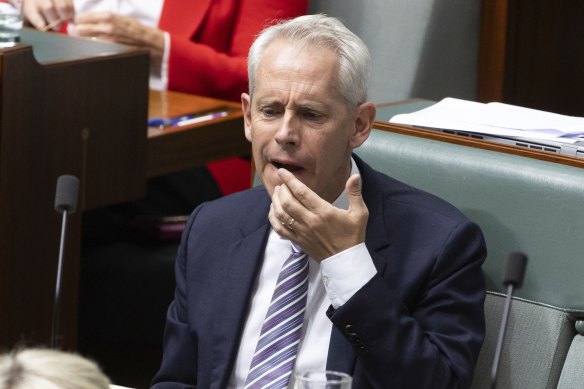- Exclusive
- Politics
- Federal
- Immigration
This was published 11 months ago
Laws for immigration detainees only drafted after landmark High Court ruling
Home Affairs officials only began drafting emergency legislation to monitor criminals released from detention two days after a High Court judgment freed them, even though officials met Immigration Minister Andrew Giles’ office several times in the lead-up to the November 8 ruling.
Departmental documents released under freedom-of-information laws show legislation for curfews and ankle monitors was being developed “at rapid pace” from November 10, a day after the opposition urged the government to act immediately.
The government’s response to the release of 153 former detainees – many with serious criminal convictions, including murder and rape – has been marked by a series of attempts to ram through laws under tight time frames while having to rely on the opposition to pass them.
Labor is also facing continued questions about the decision of a departmental delegate to remove the ankle monitor of a former detainee after he allegedly breached his curfew conditions and before he allegedly became involved in a violent home invasion on April 16.
Opposition home affairs spokesman James Paterson said the released information was “official confirmation of what we long suspected”.
“The government’s chaotic response to the High Court’s ruling in NZYQ is because they did not do their homework and weren’t ready. It’s no wonder they have been so hapless at every step since and often had to be led by the Coalition to legislate the protections the community deserves,” he said.

Immigration Minister Andrew Giles.Credit: Alex Ellinghausen
The day after the ruling, Paterson said at parliament: “We urgently need action from the Albanese government to make sure that the Australian community is safe.”
A Home Affairs spokesperson said the department had provided the government with advice on legislative options “for all possible outcomes, both prior to the hearing, after the orders were made on 8 November 2023 and following reasons being issued on 28 November 2023”.
A timeline tabled in the Senate in February showed Home Affairs officials met Giles’ office on several occasions in September and October to workshop what to do if the government lost the case brought against it by the lawyers for NZYQ, a Rohingya paedophile in indefinite detention as he could not be deported.
During a Senate estimates hearing on February 12 this year, Home Affairs general counsel Clare Sharp said officials met Giles’ office on August 8, September 14 and October 12 to discuss the case. The minister was not present.
Opposition immigration spokesman Dan Tehan said: “The fact that he didn’t bother to show up to the meetings is damning.”
Australian Border Force officials had also briefed state police on potential implications in October, before standing up a joint operation with federal police on November 10.
But a Home Affairs response to a freedom-of-information request submitted by this masthead said no draft legislation was found before the November 8 decision. Released documents show Giles approved departmental submissions to change the Migration Act on November 13 and 15, before the legislation was introduced on November 16.
“The measures in the bill, and the proposed legislation, have been developed at rapid pace in the period from 10 to 15 November 2023,” the November 15 submission says.
This masthead revealed on November 28 that the government was also considering preventative detention laws to lock up the worst offenders from the cohort again, which passed both houses of parliament by December 6 as part of the second tranche of measures in response to the ruling.
A government spokesperson said the government introduced a scheme for preventative detention within a week, referring to the time frame when officials drafted the laws from November 29, to the date they passed. “By contrast, the former Liberal government took six months to introduce their scheme for terrorists,” the spokesperson said.
No preventative detention applications have been made, with Home Affairs Minister Clare O’Neil repeatedly cautioning the legal threshold to bring them to a judge was high.
Sharp said officials began discussing the possibility of preventative detention in September, before taking options to O’Neil and Giles on October 3 – more than a month before the landmark ruling.
It comes as the government faces the prospect of more people being released from immigration detention if it loses another High Court challenge over whether detainees who refuse to co-operate with moves to deport them can be freed. The High Court will hand down its decision on Friday.
Labor has now accused the opposition of stalling critical legislation that could act as a backstop if it loses the case, after Labor tried to ram through its third tranche of immigration detention laws in March before it was deferred to a Senate inquiry.
Cut through the noise of federal politics with news, views and expert analysis. Subscribers can sign up to our weekly Inside Politics newsletter.
clarification
A previous version of this story said Home Affairs officials met with Immigration Minister Andrew Giles on several occasions in September and October. They met with members of his office rather than the minister himself.